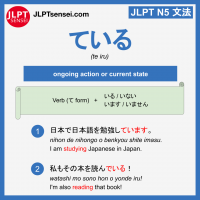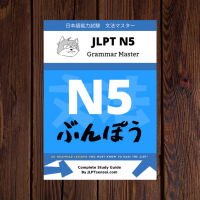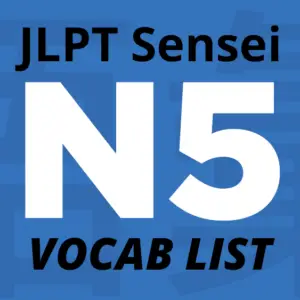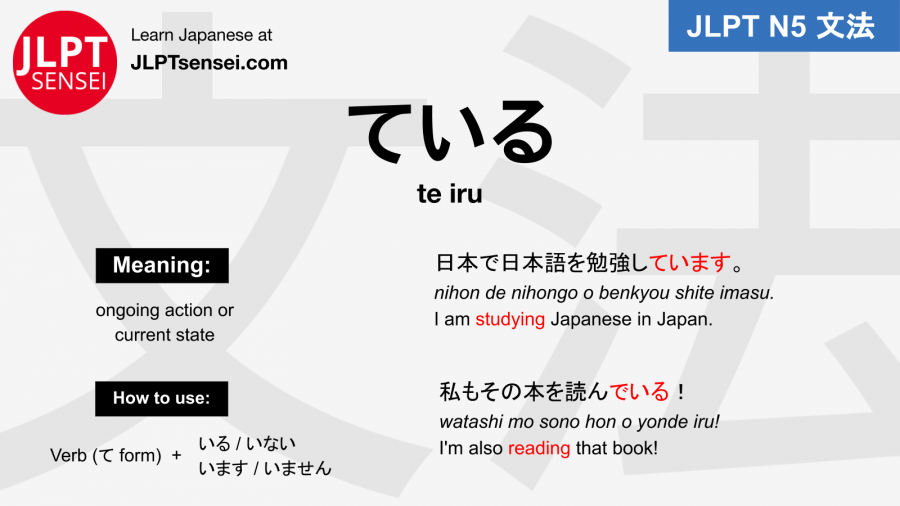Aprende gramática del idioma Japonés: ている (te iru). Significado: the progressive tense of a verb which shows that something is currently happening or ongoing.
There are a couple different ways it can be used, including:
- Progressive tense – currently doing
- Continuous – have been doing
- Present situation – what do you do now?
- Habitual actions – frequently happens
- The current state / State / condition / appearance of subject
How to conjugate progressive form ている (te iru)
This grammar point requires you convert the verb to て-form. After you do that, all you do is add いる at the end. In case you need it, here is a reminder on how to conjugate て-form. If not, skip ahead to the examples.
| Ending | Dictionary | Changes to... | て form |
|---|---|---|---|
| う verbs (u) | |||
| す | 話す(はなす) | す → して | 話して(はなして) |
| く ぐ |
書く(かく) 泳ぐ(およぐ) |
く → いて ぐ → いで |
書いて(かいて) 泳いで(およいで) |
| む ぶ ぬ |
飲む(のむ) 遊ぶ(あそぶ) 死ぬ(しぬ) |
む → んで ぶ → んで ぬ → んで |
飲んで(のんで) 遊んで(あそんで) 死んで(しんで) |
| る う つ |
切る(きる) 買う(かう) 持つ(もつ) |
る → って う → って つ → って |
切って(きって) 買って(かって) 持って(もって) |
| る Verbs (ru) | |||
| 食べる(たべる) | る → て | 食べて(たべて) | |
| Irregular Verbs (exceptions) | |||
| する | して | ||
| 来る(くる) | 来て(きて) | ||
| 行く(いく) | 行って(いって) | ||
Progressive tense basic examples
Example a)
見ている (mite iru) looking; watching; seeing
Example b)
読んでいる (yonde iru) reading
As you can see, each verb changes to a current/continuous state of doing.
However, as introduced in the beginning of this lesson, there are 5 different ways this grammar can be used. Let’s dive into each one in more detail below..
Meaning 1) Progressive tense – currently doing ている (te iru)

This is the most basic meaning, which shows that you are currently doing something at this moment.
Example 1.1)
昼ご飯を食べている。
hiru gohan o tabe teiru.
currently eating lunch now.
Example 1.2) Negative form
宿題をやっていない。
shukudai o yatte inai.
currently not doing homework.
ていない is the negative version of ている.
Example 1.3) Polite form
お母さんと電話をしています。
okaasan to denwa o shite imasu.
I am currently on the phone with my mom.
ています is the more polite version of ている.Meaning 2) Continuous – have been doing

This meaning shows that you are currently doing something and have been doing so up until now.
Example 2.1)
先生の話を聞いているの?
sensei no hanashi o kiite iru no?
Are you listening to what the teacher is saying?
Have you been listening to what the teacher is saying?
Example 2.2)
5年間日本語を勉強しています。
go nenkan nihongo o benkyou shite imasu.
I have been studying Japanese for 5 years.
Meaning 3) Present situation – what you do now

This meaning shows what you are doing now in general, not just this particular moment.
Example 3.1)
面白い本を読んでいる。
omoshiroi hon o yonde iru.
I am reading (currently or in general) an interesting book.
This example can either mean currently at this particular moment or currently as in «lately». It depends on the context of the conversation.
Example 3.2)
日本で日本語を勉強しています。
nihon de nihongo o benkyou shite imasu.
I am studying Japanese in Japan.
This example is more obvious that it is not just in this particular moment, but rather describing one’s current situation.
Meaning 4) Habitual / frequent actions

This meaning shows habitual behavior or can be used when talking about something that frequently happens.
Example 4.1)
毎日、寝る前にマンガを読んでいる。
mainichi, neru mae ni manga o yonde iru.
I read manga every day before I sleep.
Example 4.2)
いつも自転車で通勤している。
itsumo jitensha de tsukin shite iru.
I always commute by bicycle.
Meaning 5) State / condition / appearance of subject

This can be used to describe the current state of something, what something looks like, or that something was left in a certain state.
Example 5.1)
彼はお父さんと似ている。
kare wa otou-san to nite iru.
He looks (seems) like his father.
Example 5.2)
ドアが開いている。
doa ga aite iru.
The door has been left open.
This translates to the door is open, but the focus is also on the fact that the door has been left open.
Example 5.3)
今日は食堂がとても混んでいる。
kyou wa shokudou ga totemo konde iru.
The cafeteria is very crowded today.
Note that this example (and others) may cross over multiple categories. This is the same as the progressive tense, that it is «currently» crowded, but at the same time this is also describing the state of something, so it applies to both meanings.
Extra Study Notes
In summary, ている (te iru) has numerous meanings, including:
- Progressive tense – currently doing
- Continuous – have been doing
- Present situation – what do you do now?
- Habitual actions – frequently happens
- The current state / State / condition / appearance of subject
Often in conversation the い will be dropped to become てる. This is only for casual conversations.

Click the image to download the flashcard.
Download all N5 grammar flashcards.

Download our complete
JLPT N5 Grammar Master E-book.
Access ALL extra downloads, ebooks, and study guides by supporting JLPT Sensei on Patreon.
ている - Oraciones de ejemplos 例文
Cada oración de ejemplo incluye ayudas como la lectura (hiragana) en Japónes, la lectura en romaji, y la traducción en Español.
Da clic en el siguiente botón rojo para alternar todas las ayudas, o puedes dar clic en los botones individuales para mostrar únicamente las que desees ver.
Ejemplo #1
昼ごはんは何を食べているの?
Ejemplo #2
私もその本を読んでいる!
Ejemplo #3
いつからサッカーをやっているのですか。
Ejemplo #4
今日の日本は雨が降っています。
Ejemplo #5
どれくらい日本に住んでいますか?
Ejemplo #6
そのお店は何時までやっているのですか?
Ejemplo #7
山田さんはまだ寝ていると思います。
Ejemplo #8
私もあなたを愛しています。
Vocabulario 語彙
| Kanji 漢字 |
Kana カナ |
English 英語 |
|---|---|---|
| 話す | はなす | to speak; to talk; to converse |
| 書く | かく | to write; to compose; to pen; to draw |
| 読む | よむ | to read; to guess; to predict; to read (someone's thoughts) |
| 遊ぶ | あそぶ | to play; to enjoy oneself |
| 買う | かう | to buy; to purchase |
| 泳ぐ | およぐ | to swim |
| 死ぬ | しぬ | to die |
| 切る | きる | to cut |
| 持つ | もつ | to have; hold |
| する | to do | |
| 来る | くる | to come |
| 行く | いく | to go |
| 見る | みる | to look |
| 読む | よむ | to read |
| 昼ご飯 | ひるごはん | lunch |
| 食べる | たべる | to eat |
| 宿題 | しゅくだい | homework |
| お母さん | おかあさん | mother |
| 電話 | でんわ | phone |
| 先生 | せんせい | teacher |
| 話 | はなし | story |
| 聞く | きく | to listen |
| 年間 | ねんかん | years |
| 日本語 | にほんご | Japanese (language) |
| 勉強 | べんきょう | study |
| 面白い | おもしろい | interesting |
| 本 | ほん | book |
| 読む | よむ | to read |
| 毎日 | まいにち | every day |
| 寝る前 | ねるまえ | before sleeping |
| 自転車 | じてんしゃ | bicycle |
| 通勤 | つうきん | commute |
| 彼 | かれ | he |
| お父さん | おとうさん | father |
| 開ける | あける | to open |
| 今日 | きょう | today |
| 食堂 | しょくどう | cafeteria |
| 混んでいる | こんでいる | crowded |
Ver todas las lecciones de gramática del JLPT N5



